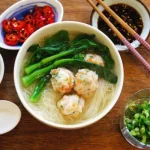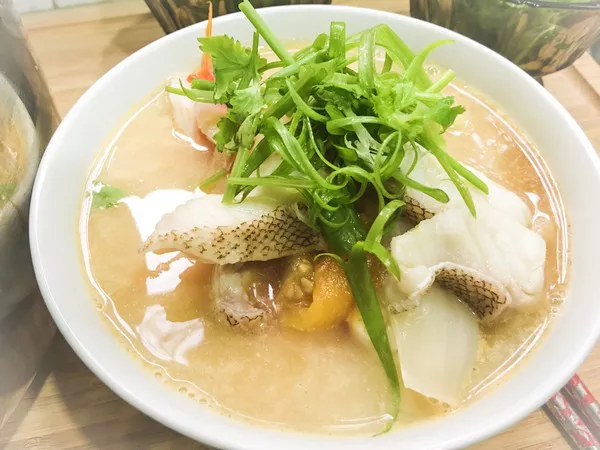Chinese cuisine is celebrated worldwide for its rich tapestry of flavors, textures, and cooking techniques. Among its diverse culinary creations, Chinese fish soup stands out as a testament to the artistry of combining fresh ingredients to create a harmonious and nutritious meal. In this comprehensive guide, we will embark on a culinary journey through the world of Chinese fish soup, exploring its history, regional variations, essential ingredients, and step-by-step recipes. Whether you’re a seasoned chef or a novice in the kitchen, this article will equip you with the knowledge and skills to create exquisite Chinese fish soups that will delight your palate and nourish your body.
The Art of Chinese Fish Soup
Chinese fish soup is a culinary masterpiece that embodies the essence of Chinese cuisine—balance, harmony, and an appreciation for fresh, seasonal ingredients. Whether served as a humble street food or a lavish banquet centerpiece, Chinese fish soup offers a delightful interplay of flavors, textures, and aromas.
At its core, Chinese fish soup is a celebration of simplicity. It begins with a clear and savory broth, often derived from simmering fish bones, aromatics, and herbs. To this base, various ingredients are added, such as fresh fish fillets, seafood, vegetables, and noodles, resulting in a nourishing and flavorful bowl that satisfies both the palate and the soul.
The History and Cultural Significance of Chinese Fish Soup
The history of Chinese fish soup is as ancient as Chinese cuisine itself, with evidence of fish-based dishes dating back thousands of years. Fish soup was an integral part of the Chinese imperial court’s culinary repertoire, where it was prepared with meticulous care and an array of premium ingredients.
Throughout Chinese history, fish soup has played a symbolic role in cultural celebrations and family gatherings. It is often featured during Lunar New Year feasts, weddings, and other significant occasions as a symbol of prosperity and abundance. The Chinese word for fish, “yu” (鱼), sounds similar to the word for surplus (余), making fish a symbol of surplus and good fortune.
In addition to its cultural significance, Chinese fish soup has garnered a reputation for its health benefits. Chinese traditional medicine emphasizes the nourishing properties of fish and fish-based broths, which are believed to support overall well-being and vitality.
Today, Chinese fish soup continues to evolve, blending traditional recipes with modern innovations. Its enduring popularity stems from its ability to adapt to changing tastes while retaining its core principles of balance and harmony.
See Also: 5 Best Frozen Fish & Their Recipes
Essential Ingredients for Chinese Fish Soup
To create an authentic Chinese fish soup, it’s essential to assemble the right ingredients. Here are the foundational elements that contribute to the soup’s depth of flavor and nutritional value:
Broth Base:
Fish Bones: Fresh fish bones are the cornerstone of the broth. Varieties like carp, sea bass, or snapper are commonly used. The bones provide a delicate sweetness and umami to the soup.
Aromatics: Aromatic ingredients like ginger, garlic, and scallions add depth and fragrance to the broth.
Herbs and Spices: Depending on the regional variation, you may use herbs like cilantro, dried tangerine peel, or star anise to infuse unique flavors.
Protein:
Fresh Fish Fillets: Choose white fish fillets such as cod, grouper, or tilapia for their tender texture and mild flavor. Slice them into thin pieces for quick cooking.
Seafood: Enhance the seafood profile with ingredients like shrimp, scallops, or squid.
See Also: 8 High-Protein Fish Varieties
Vegetables:
Leafy Greens: Bok choy, napa cabbage, or spinach add a refreshing contrast to the soup’s richness.
Mushrooms: Shiitake or wood ear mushrooms contribute a meaty texture and earthy flavor.
Tomatoes: Some regional variations incorporate tomatoes for a hint of tanginess.
Noodles or Rice:
Noodles: Egg noodles, rice vermicelli, or thick wheat noodles are often used to make the soup more filling.
Rice: In some regions, rice is added directly to the soup, creating a comforting one-pot meal.
See Also: 13+ Types of Chinese Noodles In 2023 (PLUS Pictures!)
Seasonings:
Soy Sauce: Light soy sauce adds saltiness and depth of flavor to the broth.
Salt and Pepper: Season to taste with salt and white pepper for balance.
Sesame Oil: A drizzle of sesame oil just before serving imparts a delightful nutty aroma.
With these ingredients at your disposal, you can embark on the journey of crafting Chinese fish soup that suits your taste preferences and dietary needs.
Regional Variations of Chinese Fish Soup
China’s vast expanse and regional diversity have given rise to a multitude of fish soup variations, each reflecting the unique culinary traditions of its locality. Let’s explore four distinctive regional Chinese fish soups, each with its own character and flavor profile.
1. Step-by-Step Recipe: Classic Chinese Fish Soup
Classic Chinese Fish Soup

This classic Chinese fish soup embodies the essence of simplicity and purity. It features a clear and delicate broth that allows the flavors of fresh fish and aromatics to shine through.
- Fresh fish bones (e.g., snapper or sea bass)
- Ginger slices
- Scallions
- Salt
- White pepper
- Fresh fish fillets (e.g., cod)
- Bok choy or napa cabbage
- Light soy sauce
- Light soy sauce
- Sesame oil
- Cilantro leaves (optional, for garnish)
-
Start by preparing the fish broth. In a large pot, add the fish bones, ginger slices, and scallions. Cover with water and bring to a gentle simmer. Skim off any impurities that rise to the surface. Let it simmer for about 30-40 minutes to develop the broth's flavors.
-
Strain the broth, discarding the solids. Return the clear broth to the pot.
-
Season the broth with salt and white pepper to taste.
-
Add the fresh fish fillets and cook for just a few minutes until they turn opaque and tender. Be careful not to overcook the fish.
-
In a separate pot, blanch the bok choy or napa cabbage until tender-crisp. Drain and set aside.
-
To serve, place a portion of blanched greens in each bowl, ladle the fish fillets and broth over the greens, and garnish with cilantro leaves if desired. Drizzle a small amount of light soy sauce and sesame oil over each bowl.
This classic Chinese fish soup is a testament to the beauty of simplicity and the importance of using fresh, high-quality ingredients.
2. Step-by-Step Recipe: Sichuan-Style Hot and Sour Fish Soup
Sichuan-Style Hot and Sour Fish Soup

Sichuan cuisine is renowned for its bold and fiery flavors, and this Sichuan-style hot and sour fish soup is no exception. It tantalizes the taste buds with its complex combination of heat, tanginess, and umami.
- Fresh fish bones (e.g., carp)
- Ginger slices
- Garlic cloves
- Dried red chilies
- Sichuan peppercorns
- Doubanjiang (fermented broad bean paste)
- Black vinegar
- Sugar
- Salt
- White pepper
- Fresh fish fillets (e.g., tilapia or catfish)
- Firm tofu, cubed
- Wood ear mushrooms, soaked and sliced
- Enoki mushrooms
- Eggs, beaten
- Cornstarch (optional, for thickening)
- Cilantro leaves (optional, for garnish)
-
Begin by preparing the fish broth as in the classic Chinese fish soup recipe.
-
In a separate pot, heat some oil and add ginger slices, garlic cloves, dried red chilies, and Sichuan peppercorns. Sauté until fragrant.
-
ADVERTISEMENT
Stir in the Doubanjiang (fermented broad bean paste) and cook for a minute to release its flavors.
-
Add the fish broth to the pot and bring it to a simmer.
-
Season the broth with black vinegar, sugar, salt, and white pepper, adjusting the quantities to achieve the desired balance of hot and sour flavors.
-
Add the fresh fish fillets, tofu cubes, and mushrooms to the simmering broth. Let them cook until the fish is opaque and tender.
-
Slowly pour in the beaten eggs, stirring gently to create silky ribbons of egg in the soup. If a thicker consistency is desired, you can create a slurry by mixing cornstarch with water and adding it to the soup.
-
To serve, ladle the hot and sour fish soup into bowls, garnish with cilantro leaves if desired, and enjoy the fiery and tangy flavors of Sichuan cuisine.
This Sichuan-style hot and sour fish soup is a culinary adventure for those seeking bold and spicy sensations.
3. Step-by-Step Recipe: Cantonese-Style Fish Head Noodle Soup
Cantonese-Style Fish Head Noodle Soup

Cantonese cuisine, known for its emphasis on fresh ingredients and refined flavors, offers a unique fish soup experience with the inclusion of fish head, a prized delicacy.
- Fresh fish head (e.g., grouper or red snapper)
- Ginger slices
- Scallions
- Salt
- White pepper
- Fresh fish fillets (e.g., pomfret)
- Egg noodles
- Baby bok choy
- Light soy sauce
- Sesame oil
- Cilantro leaves (optional, for garnish)
-
Begin by cleaning and preparing the fish head. Remove the gills and scales, and wash it thoroughly. Cut the fish head into manageable pieces.
-
In a large pot, add the fish head pieces, ginger slices, and scallions. Cover with water and bring to a gentle simmer. Skim off any impurities.
-
Let the broth simmer for about 30-40 minutes, allowing the fish head's natural flavors to infuse the broth.
-
Strain the broth, discarding the solids. Return the clear fish head broth to the pot.
-
Season the broth with salt and white pepper to taste.
-
Add the fresh fish fillets to the simmering broth and cook until they are opaque and tender.
-
In a separate pot, cook the egg noodles according to the package instructions. Drain and set aside.
-
Blanch the baby bok choy in the broth until tender-crisp.
-
To serve, place a portion of cooked noodles in each bowl, add fish fillets, and ladle the fish head broth over them. Add blanched baby bok choy and garnish with cilantro leaves if desired. Drizzle a small amount of light soy sauce and sesame oil over each bowl.
This Cantonese-style fish head noodle soup offers a unique blend of textures and flavors, with the fish head contributing a rich and creamy element to the dish.
4. Step-by-Step Recipe: Fujian-Style Rice Vermicelli Fish Soup
Fujian-Style Rice Vermicelli Fish Soup

Fujian cuisine, influenced by its coastal location, often features seafood in its dishes. This Fujian-style rice vermicelli fish soup is a comforting and nourishing bowl of goodness.
- Fresh fish bones (e.g., carp or sea bream)
- Ginger slices
- Scallions
- Dried shrimp
- Dried scallops
- Shiitake mushrooms, soaked and sliced
- Dried seaweed
- Rice vermicelli noodles
- Chinese cabbage (napa cabbage), chopped
- Light soy sauce
- Sesame oil
- White pepper
- Cilantro leaves (optional, for garnish)
-
Start by preparing the fish broth using fresh fish bones, ginger slices, and scallions as in the classic Chinese fish soup recipe.
-
In a separate pot, soak dried shrimp and dried scallops in hot water until they become soft and pliable. Drain and set aside.
-
Add the soaked dried shrimp, dried scallops, shiitake mushrooms, and dried seaweed to the simmering fish broth. Let them cook until rehydrated and tender.
-
Season the broth with light soy sauce, sesame oil, and white pepper to taste.
-
In a separate pot, cook the rice vermicelli noodles according to the package instructions. Drain and set aside.
-
Blanch the chopped Chinese cabbage in the broth until tender-crisp.
-
To serve, place a portion of cooked rice vermicelli noodles in each bowl, ladle the fish broth with dried seafood and vegetables over them, and garnish with cilantro leaves if desired.
This Fujian-style rice vermicelli fish soup is a heartwarming and nutritious dish that celebrates the bounty of the sea.
Tips and Techniques for Perfecting Chinese Fish Soup
Creating an exceptional Chinese fish soup requires attention to detail and some culinary finesse. Here are some tips and techniques to help you perfect your fish soup:
Select Fresh Ingredients: The quality of your fish and seafood is paramount. Choose the freshest ingredients available to ensure a clean and vibrant flavor.
Properly Clean the Fish: When using fish head or whole fish, make sure to clean and scale them thoroughly. Removing any impurities will result in a cleaner-tasting broth.
Simmer Gently: When simmering the fish bones, do so gently over low to medium heat. Avoid rapid boiling, as it can cloud the broth.
Skim Impurities: As the broth simmers, periodically skim off any impurities that rise to the surface. This will help maintain a clear and pristine broth.
Balance Seasonings: Achieving the right balance of seasonings is crucial. Taste and adjust the salt, soy sauce, and other seasonings as needed to achieve the desired flavor profile.
Timing Matters: Be mindful of cooking times for fish fillets and other ingredients. Overcooking can result in tough fish or mushy vegetables.
Pairing: Chinese fish soup pairs wonderfully with a side of steamed rice or a crusty baguette for a satisfying meal.
What is more nutritious to eat with fish soup?
Whole Grains: Opt for whole grains like brown rice, quinoa, or whole-grain bread. These options provide fiber, vitamins, and minerals that can complement the fish soup. Whole grains can help you feel fuller for longer and provide a steady source of energy.
Leafy Greens: Add a side salad or some steamed leafy greens like spinach, kale, or Swiss chard. Leafy greens are rich in vitamins, minerals, and antioxidants. They can add a refreshing and nutritious element to your meal.
Vegetables: Incorporate a variety of vegetables into your meal. Broccoli, carrots, bell peppers, and zucchini are excellent choices. Vegetables provide essential nutrients and fiber while adding color and flavor to your dish.
Legumes: Consider serving fish soup with a side of legumes like lentils, chickpeas, or beans. Legumes are a great source of plant-based protein and fiber, making them a nutritious addition to your meal.
Fruit: While it may not be a traditional accompaniment, a small serving of fresh fruit can provide a sweet and refreshing contrast to the savory fish soup. Berries, citrus fruits, or a fruit salad can be excellent choices.
Dairy or Dairy Alternatives: A dollop of Greek yogurt or a splash of coconut milk can be stirred into the soup to add creaminess and a touch of calcium. If you prefer dairy alternatives, consider options like almond milk or soy yogurt.
Nuts and Seeds: Sprinkle some chopped nuts or seeds (such as almonds, walnuts, or flaxseeds) on top of your fish soup or side dish. They provide healthy fats, protein, and crunch.
Herbs and Spices: Flavor your fish soup and side dish with fresh herbs and spices. Herbs like basil, cilantro, and parsley can add freshness, while spices like turmeric, ginger, and paprika can enhance both flavor and nutrition.
Avocado: Sliced avocado can be a creamy and nutritious addition to your fish soup. It provides healthy monounsaturated fats, fiber, and various vitamins and minerals.
Pickled or Fermented Vegetables: Items like kimchi or sauerkraut can be served as a tangy and probiotic-rich side dish that complements the flavors of fish soup.
Health Benefits of Chinese Fish Soup
Chinese fish soup is not only a delight for the taste buds but also a source of numerous health benefits:
Rich in Protein: Fish is a high-quality source of protein, essential for muscle growth and repair.
Low in Calories: Fish is relatively low in calories, making it a suitable option for those watching their calorie intake.
Omega-3 Fatty Acids: Fatty fish, like salmon and mackerel, are rich in omega-3 fatty acids, which are known to support heart health and reduce inflammation.
Collagen for Skin and Joints: Fish head and bones contain collagen, which is beneficial for skin elasticity and joint health.
Vitamins and Minerals: Fish is a good source of vitamins like B12, D, and minerals such as selenium and iodine.
Low in Saturated Fat: Fish is generally low in saturated fat, which is associated with heart disease.
Amino Acids: Fish contains essential amino acids, which are the building blocks of protein and crucial for various bodily functions.
By incorporating Chinese fish soup into your diet, you can enjoy a nourishing and balanced meal that supports your health and well-being.
See Also: A Complete Guide to Buying and Cooking the Best-Tasting Fish
Conclusion
Chinese fish soup is a culinary treasure that invites you on a journey through China’s rich and diverse gastronomic landscape. From the classic elegance of a clear fish broth to the fiery and tangy delights of Sichuan-style hot and sour fish soup, each variation offers a unique experience for the palate.
As you master the art of Chinese fish soup, you’ll not only delight in the harmonious flavors but also appreciate its cultural significance and health benefits. Whether you choose to recreate a traditional recipe or add your creative twist, Chinese fish soup promises a culinary adventure filled with flavor, nourishment, and cultural richness.
So, embrace the magic of Chinese fish soup, and let your taste buds embark on a journey that celebrates tradition, innovation, and the timeless pleasure of savoring a well-crafted bowl of soup.

